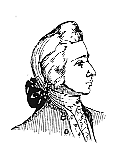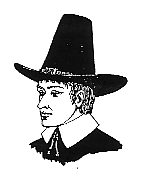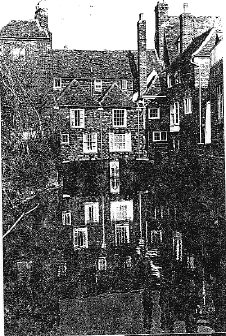A Dynasty of Vicars


During the 17th and 18th centuries, five Sacketts, from three generations of the same family, entered into Holy Orders in the Church of England.
This family can be traced back to Elizabethan times, to William Sackett, a yeoman farmer of Jordan Down, St. Johns, Margate, who died in 1572 leaving land and tenements at Jordan Down, and at Churchill and other locations in St.Peters. His will mentions his wife Johan, and six children: Alice who married Simon Norwood; Robert (c1550-1622) who married Faith Norwood, then Margaret Hart; Edward (c1555-1629) who married Alice ___, then Johan Sampson, then Rebecca Thatcher; Johan; Joyce (1562-) who married Richard Tomlin; and John.
John Sackett was baptized in 1564 at St. Laurence and married Ann (Agnes) Sampson in 1588 at St. Peters; his will of 1624 described him as a yeoman of St. Peters. John and Ann Sackett had eight children: Margaret (1589-), Marie (1591-), William (1594-1679), John (1597-1664), Robert (1599-1599), Richard (1601-1636), Ann (1603-), and Stephen (c1605-1678). Margaret's second husband, Thomas Cleybrooke, was vicar of Swalecliffe, Kent, and two of her brothers, John junior and Stephen, became vicars.
John Sackett junior matriculated in 1614, and on 20 May 1614 he was admitted to Sidney Sussex College, Cambridge University. He obtained his B.A. in 1617/18, and was ordained as a deacon in London on 12 March 1619/20, supposedly aged 27 years. (If this was true, he was 4 years old when baptised in 1597 at St. Peters, which is unlikely.) He gained his M.A. in 1621, and was made a priest at Peterborough on 24 September 1621, following which he transferred to Oxford University where he was incorporated on 9 August 1622. He was awarded his B.D. in 1628.
John had returned to Kent by March 1623/24, when he signed the parish register at Herne as curate. There may have been an element of nepotism about his appointment, as the family of Thomas Sackett (of unknown relationship to John) was already living at Herne when John arrived. With his church career launched, John wasted no time in getting married to Elizabeth Rogers, aged 15, on 19 April 1624 at Denton, Kent. Sadly, she was still only 18 years old when she died just three years later, being buried at Eythorne, Kent, on 8 November 1627. His marriage to his second wife, Sarah, was some time before 1630, but the record has not yet been located.
In 1625 and 1626, John's neat secretary hand appears in the registers of Great Mongeham, Kent, which he signed as curate. Promotion came, and he was rector of Betteshanger, Kent from 1626 to 1628. He then returned to Great Mongeham as rector, holding the post through the upheavals of the Civil War, the abolition of bishops during Cromwell's Commonwealth, and the Restoration of King Charles II. Whatever his private views, he was evidently adept at tailoring his public face to the current tide of church politics, as is made clear in the following excerpt from notes written for Archbishop Sancroft when he entered into his duties as an archdeacon soon after the Restoration:-
Mungeham Magna:– Value £120. Patron the Archbishop. Incumbent Mr John Sackett kept in all these last times, Presbyterian heretofore but now conformable, speaks much of being well known and beloved by Sir Thomas Meers. The Church much out of repayre, preaches in ye chancell, parish much infected with sectaryes (ie non-conformists). One third of ye parish at least absentees from the Church, noe surplice.

From 1628 to 1646 John was also rector of Eastbridge, Canterbury, and he was Master of Eastbridge Hospital from c1631 to 1660. The Hospital was founded next to the River Stour in the late 12th century to accommodate poor pilgrims to the shrine of St. Thomas Becket. It was re-founded in the reign of Elizabeth I for housing old people, which is still its use, and it includes a 13th-century chapel where presumably John held services.
In February 1649/50, John was involved in a Chancery Court case when Ann Eastman, widow of Edward Eastman, accused John and his brother Stephen of claiming to own six tenements which had been left to her late husband Edward by his father John Eastman in their marriage agreement, to provide her with security if she outlived Edward. John's answer was that he owned the land on 21 April 1630, long before becoming Master of Eastbridge Hospital, and leased it to Edward Eastman, who failed to do the repairs he was responsible for, and fell into arrears with the rent. Surcharge was made in the name of his brother, Richard Sackett, on circa 1 June 1635. Therefore the land could not have been left to her by the Eastmans as they had no right to it. Lengthy witness statements supported John's version of events. A year later judgement was given against Ann, but John agreed to pay her £10 and to allow her a lease to live in one of the six tenements.
John and Sarah Sackett had ten children, Sarah (1630-), John (1631-1680), Anne (1634-post 1657), Nathaniel (1636-1682), Daniel (1638-), Margaret (1640-), George (c.1642-), Samuel (-1680), Elizabeth, and Patience. Two of them, John and George, followed their father into the church. Ann was the plaintive in a Chancery Court case in May 1657, complaining that she had not received the £20 she had been left in the will of her "cozen" Samuel Frisby. The defendant was Samuel's brother George Frisby, who claimed that Samuel's estate had been insufficient to meet all his bequests, after debts had been paid. No record of a final judgement has been found; they may have settled out of court. It is probable that Sarah, Anne, and Daniel died young, as they were not mentioned in their father's will, but the Great Mongeham registers have the usual Civil War and Commonwealth gap 1640/1 to 1660/1.
John was buried 24 August 1664. He died a wealthy man; his will leaves a total of £900, and lands, tenements and a malthouse at Great Mongeham and on Thanet. John's name appears on several surviving Lay Subsidy rolls. In 1629/30 he had £3 in land on which he paid 12/- to 14/- tax. In 1642/3 he had £2 in land and paid 16/- rates. He also made a contribution of £1-10s to the Collection for the Relief of Distressed Protestants (in Ireland) made throughout England in 1641/2. In the 1664 Hearth Tax returns, he had 6 hearths (a large vicarage!), and a non-chargeable empty cottage.
John's brother Stephen Sackett attended St. John's School, Thanet, and matriculated in 1621. He was said to be 15 years old on 20 June 1621 when admitted to Sidney Sussex College, Cambridge, where he was a contemporary of Oliver Cromwell. It would indeed be interesting to know whether they were acquainted! He gained his B.A. in 1624/5, his M.A. in 1628, and a further B.A. from Oxford on 25 June 1631.
Stephen was vicar of St. Cosmos in Blean, Kent, from 1632 to 1672, and of West Hythe, Kent, from 1633 to 1679, so like his brother he managed to weather the storms of the Civil War, the Commonwealth, and the Restoration. He appears to have spent most of his time at Blean, an impression supported by the following extract from Archaeologia Cantiana, "Vicars of St. Mary, Westhythe":–
Stephen Sackett MA: instituted 2nd November 1633 on death of last incumbent.
Patron: William Kingsley, Archdeacon.
Early in June 1632 Mr Sackett was instituted to the vicarage of SS Cosmos & Damianus, Blean, on the presentation of John Boys, Esq. and the Rev. John Sackett S.T.B., Master of Eastbridge Hospital, Canterbury. Early in November the following year, Archdeacon Kingsley presented him to Westhythe. This seems to have necessitated his resignation of Blean, to which, however, he was instituted a second time in March 1634 on the presentation of the Rev. John Sackett, Master of Eastbridge Hospital. He held both benefices until his death in 1679. He paid occasional visits to Westhythe, and in October 1663 performed three Christenings there, a fourth being taken by Mr Hart of Burmarsh. A little later a memorandum by Mr Sackett occurs on one of the Transcripts, which presents a melancholy view of Church life in the district at that time :-
Burials in the parish we haue none, nor noe plase of burying, or Marrying: our church defaced: Lymph, the parish to which we should resort for religeous exercises, hauing noe Minister is seldome supplyed by any, & our Register should be kept at Limbe Church ... ... ... Steph: Sackett
[Lymph & Limbe are both Lympne]
Stephen married Alice Frisby, aged 17, on 16 July 1632 in his brother's church at Great Mongeham. They had seven children, Sarah (1633–1712), Damaris (1635–), Stephen (1638–1653), Mary (1640–), George (1643–1643), Patience (1645–), and Anne (1647–1647). In his will of 1678, Stephen left his wife all she brought on marriage and £5, land on Thanet and the remainder of his goods to Sarah, and £1 each to his other surviving daughters, Damaris, Patience, and Mary, and to two grandchildren. Clearly he was comfortably off, but not as wealthy as his brother John.
Stephen's name appears on the Lay Subsidy Roll of 1641/2, owning £2 land on which he paid 16/- rates. In the same year he made a contribution of 20/- to the Collection for the Relief of Distressed Protestants, and his name appears on the 1641/2 Protestation Returns—twice! On the return for Cosmos & Damian "Stephen Sackett (vicar)" is written in his own neat hand, but the Whitstable return has "Mr Stephen Sackett parson" written in an unfamiliar cursive hand. On the Hearth Tax return for 1664, he paid for 4 hearths, and at Michaelmas 1671, he was assessed for 5 hearths, a substantial building.
Rev. John Sackett's sons, John and George, both started their education at Sutton School, Canterbury, where George was taught by Mr Thomas Brett. John moved to the Merchant Taylors School in London, where he matriculated in 1647. He was admitted to Sidney Sussex College, Cambridge, on 6 July 1647, gaining his B.A. in 1650/51 and his M.A. in 1654. George matriculated in 1658 at Sleaford School, where he was taught by Mr Thomas Gibson, then followed the family tradition and was admitted to Sidney Sussex College on 27 April 1658, gaining his B.A. in 1661/62 and his M.A. in 1665.
Little is known of either man's career, but John was appointed a prebendary at Lincoln in 1664, the year of his father's death. George was ordained as a priest at Lincoln on 6 June 1669. Their widowed mother, Sarah Sackett, moved to Braunston, Lincolnshire, where she died in 1676. Her will was witnessed by George Sackett. His brother Samuel, gent., was living in Braunston when he wrote his will on 16 May 1680 shortly before he died, naming brother John, clerk of Braunston, as executor. John himself died a few months later, and as his will, which was proved on 4 November 1680, made no mention of his brother George, it is probable that he was already dead.
There is no evidence from any of the wills that John, George, or their brother Samuel ever married, but research is needed in Lincolnshire parish records to check this.
In his will, John of Braunston left all his lands and tenements on Thanet to his surviving brother Nathaniel, with reversion to his son John (c1670–1753), who was destined to be the last of the vicars. Nathaniel himself died in 1681/82, at which time his son John was still a schoolboy. In Nathaniel's will, John was left a messuage, appurtenances and lands at Sackett's Hill in the parishes of St. Peter and St. John, Thanet, to be run by his mother, Anne, until he was 21, and he was to be "sent to university as soon as fitting".
John's education began at King's School, Canterbury. He matriculated from Pembroke College at Easter 1686 and was admitted to Corpus Christi College, Cambridge in 1688. He gained his B.A. in 1690/91, and was ordained as a deacon at Lincoln on 12 February 1692/93. Following his M.A. in 1694, he was ordained as a priest in London on 8 March 1695/96. He was curate of Folkestone, Kent from 1699 to 1753, and preached the sermon at the Archbishop's Visitation on 23 May 1702. Another pluralist, he was also rector of Hawkinge, Kent from 1713 to 1753, vicar of West Hythe, Kent from 1732 to 1753, and Master of Eastbridge Hospital, Canterbury from 1746 to 1753.
He was known as an antiquary, poet and epigrammatist, and in 1747 Gentleman's Magazine published a translation of John's distich "Ad Uxorem"
Make of our house a beehive, spouse!
Be waspish! Drones attack!
But be to me a busy bee,
Be honey to old Sack.
In his book The Sacketts of America, Weygant claimed that John wrote a scientific work in 1716, "Sinking of the Earth near Folkestone, Kent" (although I have yet to confirm this).
John married twice, but does not appear to have had any children. He obtained a licence to marry Margaret Tempest on 24 October 1702; no record of the marriage has yet been located. She died on 21 November 1727, and he married Margaret Lunn at St. Alphage, Canterbury, on 22 April 1729. When he died, John's will left everything to his wife. He was buried 28 January 1753 at Hawkinge. Margaret moved to Barham, Kent, where she made an extremely detailed will in 1766. She was buried, aged 91, at Denton on 23 March 1769.
John's career is confirmed by the following extract from Archaeologia Cantiana, "Vicars of St. Mary, Westhythe", which also sheds light on the character of his wife (although I suspect the author may have confused Margaret Tempest, who died in 1727, with his second wife Margaret Lunn, who would have been alive to receive a bequest in 1743.)
John Sackett MA: instituted 14th June 1732, on cess[ation] of the last [incumbent]
Patron: Samuel Lisle, Archdeacon.
Of Corpus Coll., Cambridge. BA 1690, MA 1694. He was appointed to the cure of Folkestone in 1699. Three years later he married Mrs Margaret Tempest, a lady of Patricksbourne, whose goodness of heart was so gratefully appreciated by the Rev. Henry Bilton, Rector of Cheriton, that at his decease, in 1743, he bequeathed to her £300, desiring her "to accept of the same as a Gratuity for the trouble and Care she has had of me". In November 1713 the Rev. Robert Daniel, Rector of Hawkinge, died, and Archbishop Temson conferred the vacant benefice on Mr Sackett, who was instituted the following January. In 1732 Archdeacon Lisle presented him to Westhythe; and in March 1746/7 Archbishop Potter conferred on him the Mastership of Eastbridge Hospital, Canterbury. All these preferments were held by him at the time of his death.